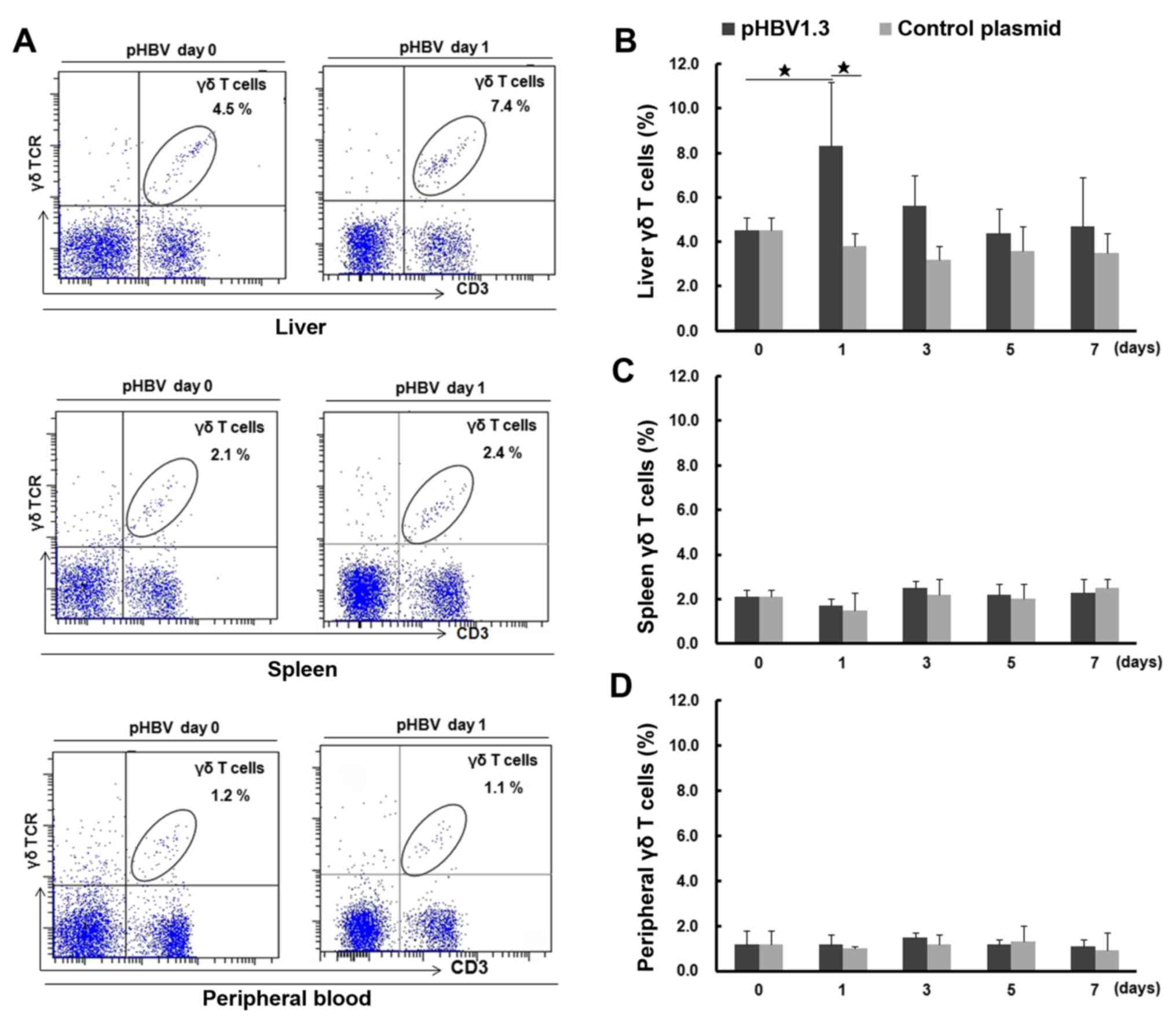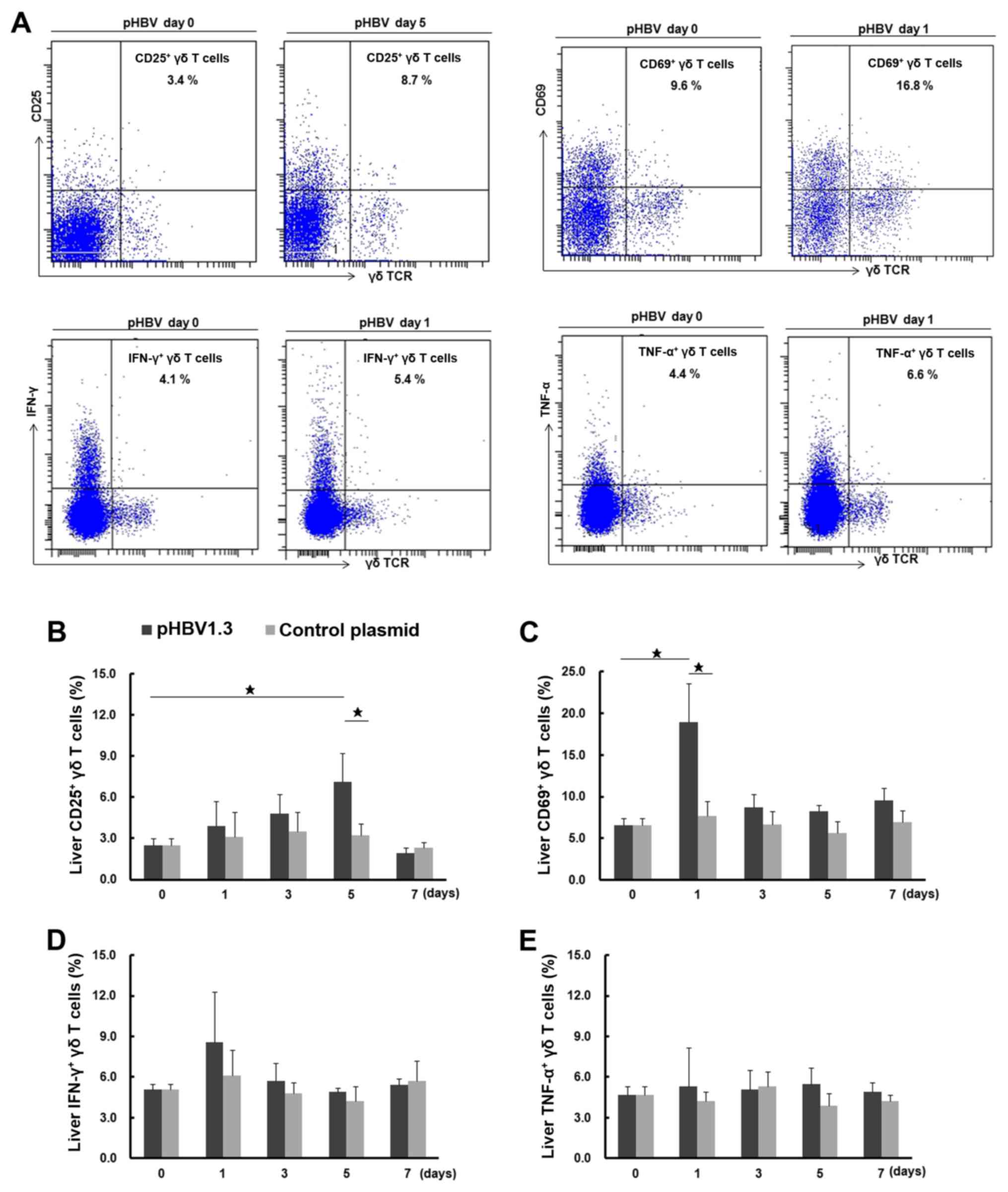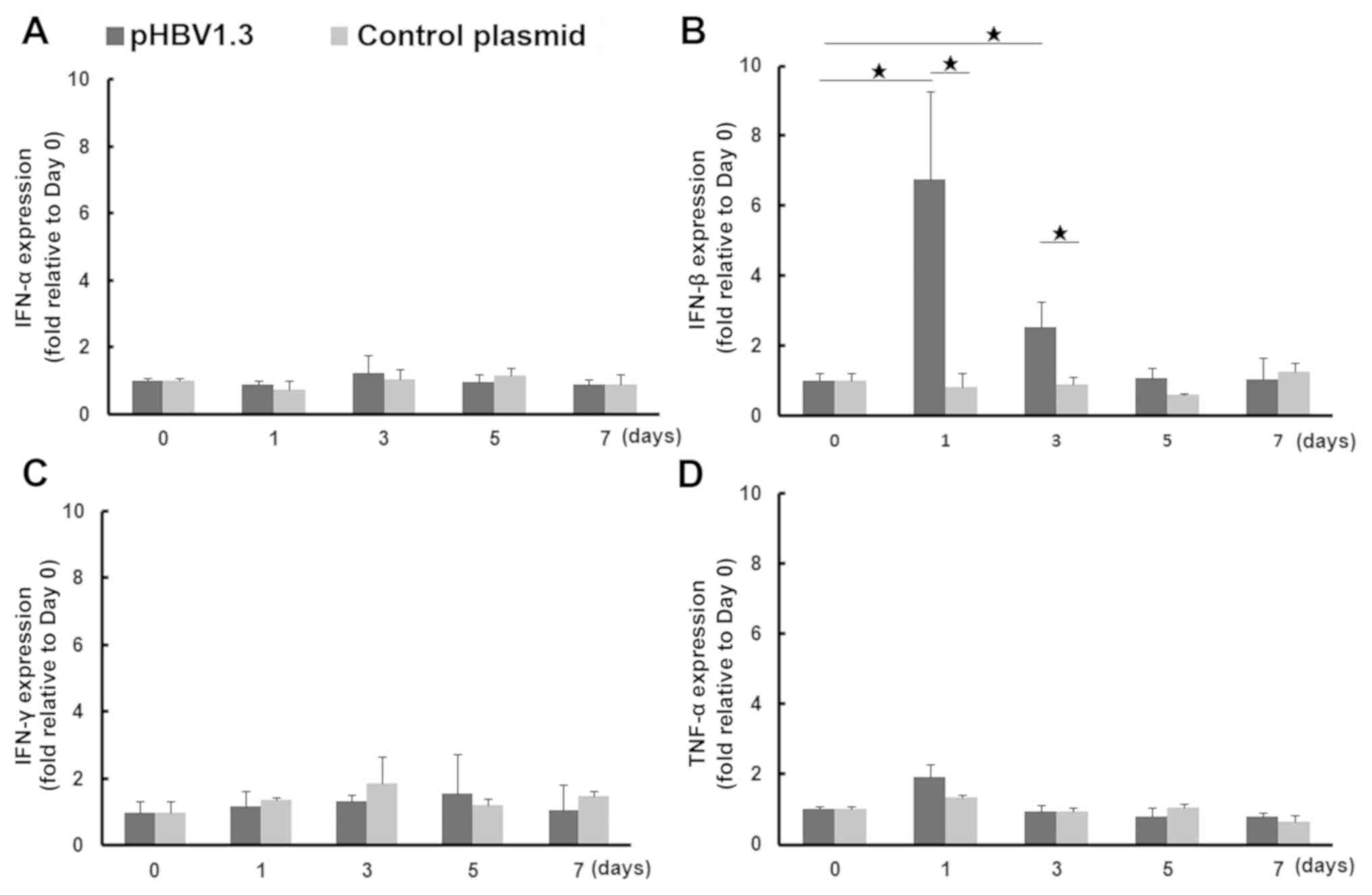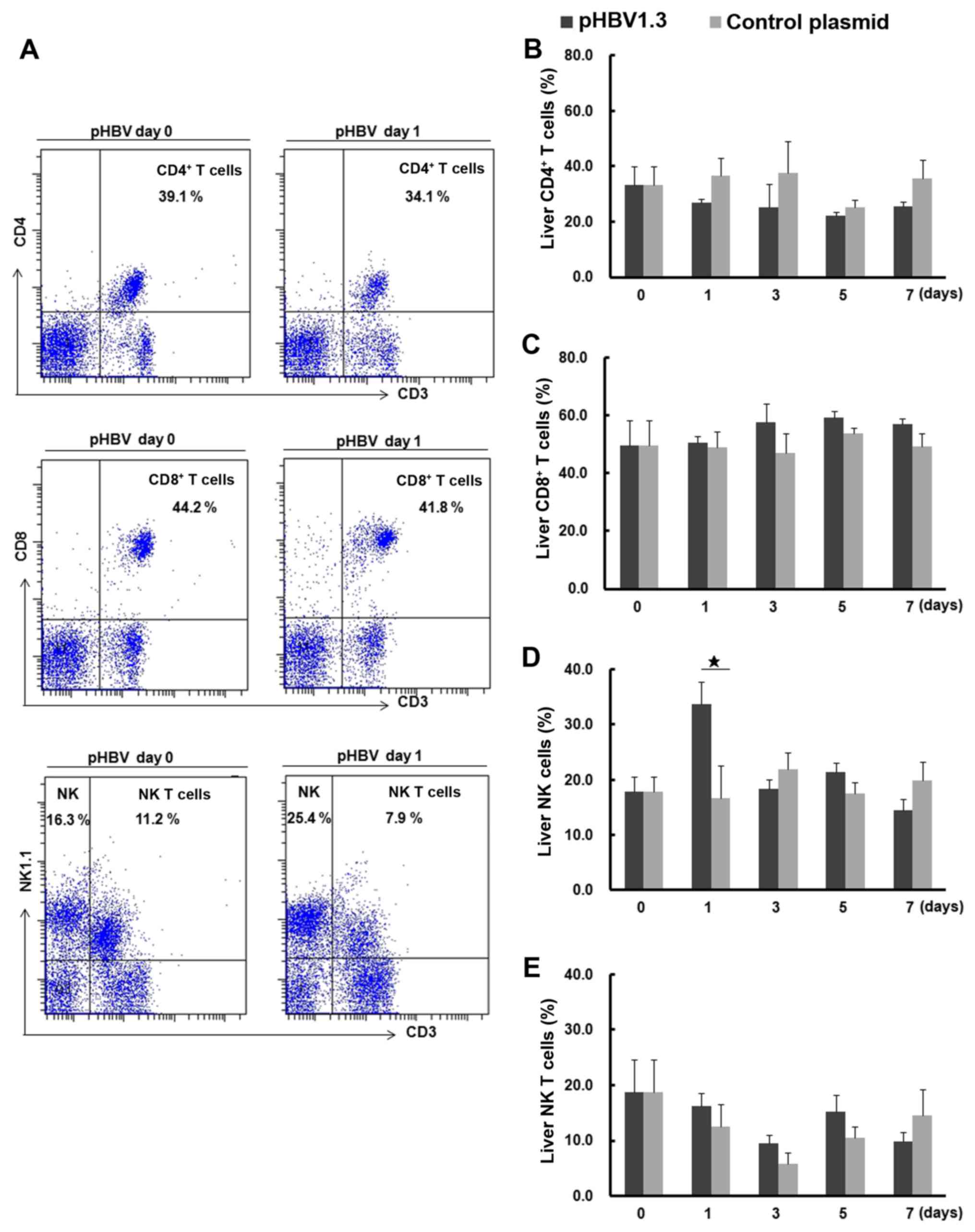|
1
|
Seto WK, Lo YR, Pawlotsky JM and Yuen MF:
Chronic hepatitis B virus infection. Lancet. 392:2313–2324. 2018.
View Article : Google Scholar : PubMed/NCBI
|
|
2
|
Tang LSY, Covert E, Wilson E and Kottilil
S: Chronic hepatitis B infection: A review. JAMA. 319:1802–1813.
2018. View Article : Google Scholar : PubMed/NCBI
|
|
3
|
Tsai KN, Kuo CF and Ou JJ: Mechanisms of
hepatitis B virus persistence. Trends Microbiol. 26:33–42. 2018.
View Article : Google Scholar : PubMed/NCBI
|
|
4
|
Yan H, Zhong G, Xu G, He W, Jing Z, Gao Z,
Huang Y, Qi Y, Peng B, Wang H, et al: Sodium taurocholate
cotransporting polypeptide is a functional receptor for human
hepatitis B and D virus. Elife. 1:e000492012. View Article : Google Scholar : PubMed/NCBI
|
|
5
|
Chang JJ and Lewin SR: Immunopathogenesis
of hepatitis B virus infection. Immunol Cell Biol. 85:16–23. 2007.
View Article : Google Scholar : PubMed/NCBI
|
|
6
|
Gehring AJ and Protzer U: Targeting innate
and adaptive immune responses to cure chronic HBV infection.
Gastroenterology. 156:325–337. 2019. View Article : Google Scholar : PubMed/NCBI
|
|
7
|
Guy CS, Mulrooney-Cousins PM, Churchill ND
and Michalak TI: Intrahepatic expression of genes affiliated with
innate and adaptive immune responses immediately after invasion and
during acute infection with woodchuck hepadnavirus. J Virol.
82:8579–8591. 2008. View Article : Google Scholar : PubMed/NCBI
|
|
8
|
Stevens KE, Thio CL and Osburn WO: CCR5
deficiency enhances hepatic innate immune cell recruitment and
inflammation in a murine model of acute hepatitis B infection.
Immunol Cell Biol. 97:317–325. 2019. View Article : Google Scholar : PubMed/NCBI
|
|
9
|
Murray JM, Wieland SF, Purcell RH and
Chisari FV: Dynamics of hepatitis B virus clearance in chimpanzees.
Proc Natl Acad Sci USA. 102:17780–17785. 2005. View Article : Google Scholar : PubMed/NCBI
|
|
10
|
Yang PL, Althage A, Chung J and Chisari
FV: Hydrodynamic injection of viral DNA: A mouse model of acute
hepatitis B virus infection. Proc Natl Acad Sci USA.
99:13825–13830. 2002. View Article : Google Scholar : PubMed/NCBI
|
|
11
|
Yang PL, Althage A, Chung J, Maier H,
Wieland S, Isogawa M and Chisari FV: Immune effectors required for
hepatitis B virus clearance. Proc Natl Acad Sci USA. 107:798–802.
2010. View Article : Google Scholar : PubMed/NCBI
|
|
12
|
Lin Y, Huang X, Wu J, Liu J, Chen M, Ma Z,
Zhang E, Liu Y, Huang S, Li Q, et al: Pre-activation of toll-like
receptor 2 enhances CD8+ T-cell responses and
accelerates hepatitis B virus clearance in the mouse models. Front
Immunol. 9:14952018. View Article : Google Scholar : PubMed/NCBI
|
|
13
|
Chang WW, Su IJ, Lai MD, Chang WT, Huang W
and Lei HY: The role of inducible nitric oxide synthase in a murine
acute hepatitis B virus (HBV) infection model induced by
hydrodynamics-based in vivo transfection of HBV-DNA. J Hepatol.
39:834–842. 2003. View Article : Google Scholar : PubMed/NCBI
|
|
14
|
Golsaz-Shirazi F, Amiri MM and Shokri F:
Immune function of plasmacytoid dendritic cells, natural killer
cells, and their crosstalk in HBV infection. Rev Med Virol.
28:e20072018. View
Article : Google Scholar : PubMed/NCBI
|
|
15
|
Peeridogaheh H, Meshkat Z, Habibzadeh S,
Arzanlou M, Shahi JM, Rostami S, Gerayli S and Teimourpour R:
Current concepts on immunopathogenesis of hepatitis B virus
infection. Virus Res. 245:29–43. 2018. View Article : Google Scholar : PubMed/NCBI
|
|
16
|
Fisicaro P, Valdatta C, Boni C, Massari M,
Mori C, Zerbini A, Orlandini A, Sacchelli L, Missale G and Ferrari
C: Early kinetics of innate and adaptive immune responses during
hepatitis B virus infection. Gut. 58:974–982. 2009. View Article : Google Scholar : PubMed/NCBI
|
|
17
|
Lawand M, Déchanet-Merville J and
Dieu-Nosjean MC: Key features of gamma-delta T-cell subsets in
human diseases and their immunotherapeutic implications. Front
Immunol. 8:7612017. View Article : Google Scholar : PubMed/NCBI
|
|
18
|
Kabelitz D and Déchanet-Merville J:
Editorial: ‘Recent advances in gamma/delta T cell biology: New
ligands, new functions, and new translational perspectives’. Front
Immunol. 6:3712015. View Article : Google Scholar : PubMed/NCBI
|
|
19
|
Rajoriya N, Fergusson JR, Leithead JA and
Klenerman P: Gamma delta T-lymphocytes in hepatitis C and chronic
liver disease. Front Immunol. 5:4002014. View Article : Google Scholar : PubMed/NCBI
|
|
20
|
Khairallah C, Netzer S, Villacreces A,
Juzan M, Rousseau B, Dulanto S, Giese A, Costet P, Praloran V,
Moreau JF, et al: γδ T cells confer protection against murine
cytomegalovirus (MCMV). PLoS Pathog. 11:e10047022015. View Article : Google Scholar : PubMed/NCBI
|
|
21
|
Howard J, Zaidi I, Loizon S,
Mercereau-Puijalon O, Déchanet-Merville J and Mamani-Matsuda M:
Human Vγ9Vδ2 T Lymphocytes in the Immune Response to P.
falciparum Infection. Front Immunol. 9:27602018. View Article : Google Scholar : PubMed/NCBI
|
|
22
|
Chen M, Zhang D, Zhen W, Shi Q, Liu Y,
Ling N, Peng M, Tang K, Hu P, Hu H and Ren H: Characteristics of
circulating T cell receptor gamma-delta T cells from individuals
chronically infected with hepatitis B virus (HBV): An association
between V(delta)2 subtype and chronic HBV infection. J Infect Dis.
198:1643–1650. 2008. View
Article : Google Scholar : PubMed/NCBI
|
|
23
|
Conroy MJ, Mac Nicholas R, Taylor M, O'Dea
S, Mulcahy F, Norris S and Doherty DG: Increased frequencies of
circulating IFN-γ-producing Vδ1(+) and Vδ2(+) γδ T cells in
patients with asymptomatic persistent hepatitis B virus infection.
Viral Immunol. 28:201–208. 2015. View Article : Google Scholar : PubMed/NCBI
|
|
24
|
Kong X, Sun R, Chen Y, Wei H and Tian Z:
γδT cells drive myeloid-derived suppressor cell-mediated CD8+ T
cell exhaustion in hepatitis B virus-induced immunotolerance. J
Immunol. 193:1645–1653. 2014. View Article : Google Scholar : PubMed/NCBI
|
|
25
|
Huang M, Sun R, Huang Q and Tian Z:
Technical improvement and application of hydrodynamic gene delivery
in study of liver diseases. Front Pharmacol. 8:5912017. View Article : Google Scholar : PubMed/NCBI
|
|
26
|
Li L, Li S, Zhou Y, Yang L, Zhou D, Yang
Y, Lu M, Yang D and Song J: The dose of HBV genome contained
plasmid has a great impact on HBV persistence in hydrodynamic
injection mouse model. Virol J. 14:2052017. View Article : Google Scholar : PubMed/NCBI
|
|
27
|
China National Standardization
Administration, . Guidelines for the Care and Use of Laboratory
Animals in China. http://www.gb688.cn/bzgk/gb/newGbInfo?hcno=9BA619057D5C13103622A10FF4BA5D14February
6–2018
|
|
28
|
Duwaerts CC, Sun EP, Cheng CW, van Rooijen
N and Gregory SH: Cross-activating invariant NKT cells and kupffer
cells suppress cholestatic liver injury in a mouse model of biliary
obstruction. PLoS One. 8:e797022013. View Article : Google Scholar : PubMed/NCBI
|
|
29
|
Zhang H, Fu R, Guo C, Huang Y, Wang H,
Wang S, Zhao J and Yang N: Anti-dsDNA antibodies bind to TLR4 and
activate NLRP3 inflammasome in lupus monocytes/macrophages. J
Transl Med. 14:1562016. View Article : Google Scholar : PubMed/NCBI
|
|
30
|
Li L, Cha H, Yu X, Xie H, Wu C, Dong N and
Huang J: The characteristics of NK cells in Schistosoma
japonicum-infected mouse spleens. Parasitol Res. 114:4371–4379.
2015. View Article : Google Scholar : PubMed/NCBI
|
|
31
|
Livak KJ and Schmittgen TD: Analysis of
relative gene expression data using real-time quantitative PCR and
the 2(-Delta Delta C(T)) method. Methods. 25:402–408. 2001.
View Article : Google Scholar : PubMed/NCBI
|
|
32
|
Inatsuka C, Yang Y, Gad E, Rastetter L,
Disis ML and Lu H: Gamma delta T cells are activated by
polysaccharide K (PSK) and contribute to the anti-tumor effect of
PSK. Cancer Immunol Immunother. 62:1335–1345. 2013. View Article : Google Scholar : PubMed/NCBI
|
|
33
|
Melchjorsen J: Learning from the
messengers: Innate sensing of viruses and cytokine regulation of
immunity-clues for treatments and vaccines. Viruses. 5:470–527.
2013. View Article : Google Scholar : PubMed/NCBI
|
|
34
|
Nosratabadi R, Alavian SM, Zare-Bidaki M,
Shahrokhi VM and Arababadi MK: Innate immunity related pathogen
recognition receptors and chronic hepatitis B infection. Mol
Immunol. 90:64–73. 2017. View Article : Google Scholar : PubMed/NCBI
|
|
35
|
Tzeng HT, Tsai HF, Chyuan IT, Liao HJ,
Chen CJ, Chen PJ and Hsu PN: Tumor necrosis factor-alpha induced by
hepatitis B virus core mediating the immune response for hepatitis
B viral clearance in mice model. PLoS One. 9:e1030082014.
View Article : Google Scholar : PubMed/NCBI
|
|
36
|
Boni C, Fisicaro P, Valdatta C, Amadei B,
Di Vincenzo P, Giuberti T, Laccabue D, Zerbini A, Cavalli A,
Missale G, et al: Characterization of hepatitis B virus
(HBV)-specific T-cell dysfunction in chronic HBV infection. J
Virol. 81:4215–4225. 2007. View Article : Google Scholar : PubMed/NCBI
|
|
37
|
Bertoletti A and Ferrari C: Adaptive
immunity in HBV infection. J Hepatol. 64 (1 Suppl):S71–S83. 2016.
View Article : Google Scholar : PubMed/NCBI
|
|
38
|
Yoshio S and Kanto T: Host-virus
interactions in hepatitis B and hepatitis C infection. J
Gastroenterol. 51:409–420. 2016. View Article : Google Scholar : PubMed/NCBI
|
|
39
|
Deniger DC, Moyes JS and Cooper LJ:
Clinical applications of gamma delta T cells with multivalent
immunity. Front Immunol. 5:6362014. View Article : Google Scholar : PubMed/NCBI
|
|
40
|
Wu YL, Ding YP, Tanaka Y, Shen LW, Wei CH,
Minato N and Zhang W: γδ T cells and their potential for
immunotherapy. Int J Biol Sci. 10:119–135. 2014. View Article : Google Scholar : PubMed/NCBI
|
|
41
|
Paul S and Lal G: Regulatory and effector
functions of gamma-delta (γδ) T cells and their therapeutic
potential in adoptive cellular therapy for cancer. Int J Cancer.
139:976–985. 2016. View Article : Google Scholar : PubMed/NCBI
|
|
42
|
Wang H, Luo H, Wan X, Fu X, Mao Q, Xiang
X, Zhou Y, He W, Zhang J, Guo Y, et al: TNF-α/IFN-γ profile of
HBV-specific CD4 T cells is associated with liver damage and viral
clearance in chronic HBV infection. J Hepatol. Sep 6–2019.(Epub
ahead of print). View Article : Google Scholar
|
|
43
|
Wohler JE, Smith SS, Zinn KR, Bullard DC
and Barnum SR: Gammadelta T cells in EAE: Early trafficking events
and cytokine requirements. Eur J Immunol. 39:1516–1526. 2009.
View Article : Google Scholar : PubMed/NCBI
|
|
44
|
Ma Z, Ni G and Damania B: Innate sensing
of DNA virus genomes. Annu Rev Virol. 5:341–362. 2018. View Article : Google Scholar : PubMed/NCBI
|
|
45
|
Brubaker SW, Bonham KS, Zanoni I and Kagan
JC: Innate immune pattern recognition: A cell biological
perspective. Annu Rev Immunol. 33:257–290. 2015. View Article : Google Scholar : PubMed/NCBI
|
|
46
|
Wieland S, Thimme R, Purcell RH and
Chisari FV: Genomic analysis of the host response to hepatitis B
virus infection. Proc Natl Acad Sci USA. 101:6669–6674. 2004.
View Article : Google Scholar : PubMed/NCBI
|
|
47
|
Tseng CT, Miskovsky E, Houghton M and
Klimpel GR: Characterization of liver T-cell receptor gammadelta T
cells obtained from individuals chronically infected with hepatitis
C virus (HCV): Evidence for these T cells playing a role in the
liver pathology associated with HCV infections. Hepatology.
33:1312–1320. 2001. View Article : Google Scholar : PubMed/NCBI
|
|
48
|
Abravanel F, Barragué H, Dörr G, Sauné K,
Péron JM, Alric L, Kamar N, Izopet J and Champagne E: Conventional
and innate lymphocytes response at the acute phase of HEV infection
in transplanted patients. J Infect. 72:723–730. 2016. View Article : Google Scholar : PubMed/NCBI
|
|
49
|
Wu D, Yan WM, Wang HW, Huang D, Luo XP and
Ning Q: γδ T cells contribute to the outcome of murine fulminant
viral hepatitis via effector cytokines TNF-α and IFN-γ. Curr Med
Sci. 38:648–655. 2018. View Article : Google Scholar : PubMed/NCBI
|
|
50
|
Yoneda M, Hyun J, Jakubski S, Saito S,
Nakajima A, Schiff ER and Thomas E: Hepatitis B virus and DNA
stimulation trigger a rapid innate immune response through NF-κB. J
Immunol. 197:630–643. 2016. View Article : Google Scholar : PubMed/NCBI
|
|
51
|
Heymann F and Tacke F: Immunology in the
liver-from homeostasis to disease. Nat Rev Gastroenterol Hepatol.
13:88–110. 2016. View Article : Google Scholar : PubMed/NCBI
|















